Entries in wind farm ordinances (7)
9/15/10 Why are there so many complaints about living with wind turbine noise? AND What's going on with the wind siting rules? AND Can I get some maintenance for this turbine? What do you mean you're bankrupt? AND Mafia discovers a clean, green, dirty money laundering machine
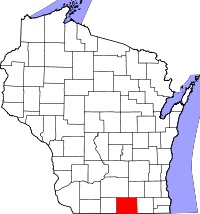 Wisconsin small business owner, Jim Bembinster, knows a lot about the complicated subject of wind turbine noise.
Wisconsin small business owner, Jim Bembinster, knows a lot about the complicated subject of wind turbine noise.
He spent 14 months focusing on noise issues as a member of the Large Turbine Wind Study Committee for the Town of Union (Rock County). He also helped author the Town of Union Large Wind Ordinance, considered by many to be the best in the state.
This ordinance has been adopted by local governments throughout Wisconsin, including five contiguous Towns in Rock County. Local governments from other states have used it for a model in creating their own ordinances.
The Town of Union Ordinance calls for a turbine noise limit of five decibels over the existing noise levels in the community.
The wind siting rules approved by the Public Service Commission, which preempt ordinances like the Town of Union’s, allow a nighttime noise level of 45dba—or an approximate increase of 20 decibels over normal rural noise limits.
Here, Mr. Bembinster explains how a 20 decibel increase will impact a rural community, and why masking turbine noise is so difficult.
The general rule for additional noise is this:
Adding 5dB is barely noticeable.
Adding 10dB is clearly heard— as it’s twice again as loud.
Adding 15 dB is very loud and this will become the dominant sound.
If ambient [existing] noise levels in a rural community are 25dB and turbine noise levels are at 45dB, there will be a problem.
The reason is the turbine, at 20dB louder, will be the dominant sound.
Although developers say noise from the turbine will be masked by other environmental sound, such as the wind blowing through the trees, a noise loud enough to cover the turbine must also be similar in character and at least 15 decibels louder, which puts it at least 60dB. This would be something like a the noise from a large truck going by or a Harley.
Also, in order to mask the sound, the character of the two types of sound must be the same.
Take the example of a baby crying.
If you were in a room with people who were all having a conversation at say 50dB and a baby started to cry at 40dB, the baby’s cry would be clearly heard over the conversation because of the difference of character and the tone of the noise it makes.
If the baby ramps up the crying to 50dB --the same sound level as the conversation in the room, the baby’s cry will become the dominant sound in the room even though both the crying and the conversation are at the same decibel level.
This is why people trapped in wind farms have trouble with the noise even though the turbine is within its noise limits of 45dB. Ambient sounds in a rural area can’t mask the sound of a turbine because the quality of the noise is so different, much like difference between a baby crying and adult conversation.
Another way to look at is how loud it would need to be inside your home so that a Harley could pass by unnoticed. That would be really loud, and not the best circumstance for sleeping.
There is nothing in a rural community that makes a sound similar enough to a wind turbine to mask it, except perhaps a jet or helicopter passing overhead, which is exactly what wind turbine noise is often compared to by those now living in wind projects.
SECOND STORY
WIND TURBINE RULE CAN BE REVISED, PANEL SAYS;
CHANGE WOULD ADDRESS POSSIBLE HEALTH EFFECTS
SOURCE: Green Bay Press Gazette, www.greenbaypressgazette.com
September 16 2010
By Tony Walter
One of the three members of the Public Service Commission who voted for the wind turbine siting rules last month noted in a letter to two top state lawmakers that the panel can revise the rules to address the potentially harmful health effects of the turbines.
“While I support the overall rule because it will promote the development of wind in Wisconsin, the rule fails to provide a much-needed safety net for people whose health declines because of a wind turbine located near their home,” Commissioner Lauren Azar wrote to legislative officials in an Aug. 31 letter.
“As new information becomes available, the Commission can revise this rule.”
Azar wasn’t available this week to comment on her proposal that would require wind turbine owners to purchase the home of anyone who can prove that the turbine has a significant adverse health outcome. An aide in her office said Azar’s letter speaks for itself.
Invenergy LLC wants to build a 100-turbine wind farm in the towns of Morrison, Glenmore, Wrightstown and Holland with turbines that produce more than 100-megawatts of energy. CH Shirley Wind LLC is erecting eight 20-megawatt turbines in Glenmore.
An Invenergy spokesman said last month that the company plans to resubmit its application for the Ledge Wind Farm project, noting that the health issue has been studied by numerous groups that concluded there is insufficient evidence to prove the turbines put people and animals at risk.
That proposal has prompted the creation of a Brown County citizens group speaking out against the wind turbine industry, arguing there hasn’t been sufficient study on health impacts.
Carl Kuehne, a member of the board of directors of the Brown County Citizens for Responsible Wind Energy, said the absence of definitive evidence on the health impact of wind turbines is reason enough to conduct more studies.
“No. 1, there is no need to move ahead today with more wind turbines in Wisconsin,” Kuehne said.
“The utilities are currently meeting the energy mandates set by the state government. So let’s study the situation. There’s certainly enough ad hoc evidence that wind turbines do have an impact on people and animals. Let’s study it and find out before we create more destruction on people. We have the opportunity.”
Last month, the PSC adopted rules for projects less than 100 megawatts. The rules can be altered by the state Legislature and lawmakers can ask the PSC to make changes. The issue has been assigned to the Assembly’s Committee on Energy and Utilities, which is led by Jim Soletski, D-Ashwaubenon, but no meeting date has been set.
THIRD STORY:
BANKRUPTCY RAISES WIND TURBINE ISSUES
September 16, 2010
By Bruce Burdett
PORTSMOUTH — With its wind turbine supplier bankrupt, Portsmouth is looking for a new company to provide the service it had believed was covered under the equipment’s original warranty.
Bankruptcy proceedings for Canadian firm AAER were completed in July. Pioneer Power Solutions bought some of AAER’s assets ”but appears unwilling to provide warranty coverage or operations and maintenance support,” Finance Director David Faucher wrote in a Sept. 8 memo to the town council.
Mr. Faucher and Assistant Town Planner Gary Crosby, who has overseen much of the town’s wind turbine effort, said they have met with representatives of Templeton Power and Light which has commissioned an AAER wind turbine generator similar to Portsmouth’s in hopes of partnering with the Massachusetts utility for a long term maintenance services contract.
But Mr. Faucher said Templeton is not yet at a point that it can enter into such a partnership.
So for now, Mr. Faucher recommended that the town council enter into an emergency one-year maintenance and service agreement with Solaya, a division of Lumus Constrictoon Inc. of Woburn, Mass. The council was scheduled to discuss and possibly vote on the agreement at its meeting on Wednesday this week (after the Times went to press).
The agreement would include two 6-month scheduled maintenance sessions (the first being this month), around-the-clock monitoring and unscheduled maintenance. At the end of the year, Mr. Faucher said he would ask the council to award a competitively bid contract for a three-year period.
The agreement with Solaya is “very detailed and describes the monitoring , warranty protction and maintenance services we have been seeking.”
Cost of the year’s basic service is $33,000, and the town would be charged additional fees for extra work.
FOURTH STORY
SOURCE: The Independent, www.independent.co.uk
MAFIA'S DIRTY MONEY LINKED TO CLEAN ENERGY
September 16 2010
By Michael Day in Milan,
After decades of drug-running, extortion and prostitution, the Mafia appears to have found a rather more ecological way of laundering their money: green power.
And if the assets of the Italian police’s latest target are any indication, the Mafia is embracing the renewable energy business with an enthusiasm that would make Al Gore look like a dilettante. The surprising revelation of organised crime’s new green streak came as Italian police said yesterday they had made the largest recorded seizure of mob assets – worth €1.5bn (£1.25bn) – from the Mafia-linked Sicilian businessman Vito Nicastri, who had vast holdings in alternative energy concerns, including wind farms.
Organised crime in Italy has previously been notorious for trading in environmental destruction – principally earning billions of euros by illegally dumping toxic waste. But most of the newly seized assets are in the form of land, property and bank accounts in Sicily, the home of Cosa Nostra, and in the neighbouring region of Calabria, the base of the rival ‘Ndrangheta crime syndicate.
Police said the operation was based on a 2,400-page investigative report and followed 54-year-old Mr Nicastri’s arrest last year. He has since been released without charge, and has denied wrongdoing. But General Antonio Girone, the head of the national anti-Mafia agency DIA, said that Mr Nicastri, known as “lord of the winds”, was linked to Matteo Messina Denaro, the fugitive believed to be the Sicilian Mafia’s “boss of bosses”.
Senator Costantino Garraffa, of the parliamentary anti-Mafia committee, said the Mafia was trying to break into the “new economy” of alternative energy as it sought to launder money earned from crime. The seizure of Mr Nicastri’s assets “confirms the interest that organised crime has in renewable energy, which several annual reports on environmental issues have already stressed,” added Beppe Ruggiero, an official with the anti-Mafia association Libera.
Generous subsidies have led to rapid growth in wind power in Italy in recent years. Mr Ruggiero said: “It is very important for this sector to stay far from Mafia activities.” However, he stressed the need for renewable energy to develop in Italy’s poorer South. “Investment in renewable energy should not be discouraged,” he said, adding that the nuclear alternative would be “a losing choice”.
Recent estimates suggest the total annual turnover of Italy’s main organised crime groups is around €100bn (£83bn), or 7 per cent of GDP. Officials, including the Bank of Italy governor, Mario Draghi, have argued that organised crime has perpetuated poverty in the south of the country.
9/2/10 Show me the safety net: PSC commissioner Lauren Azar's letter to legislators AND Show me the green jobs: Wisconsin wind employment figures wither under scrutiny AND What to expect when you're expecting 497 foot tall turbines: Construction begins on Wind Siting Council Member Bill Rakocy's new wind farm AND a letter from Maine that could be from Wisconsin
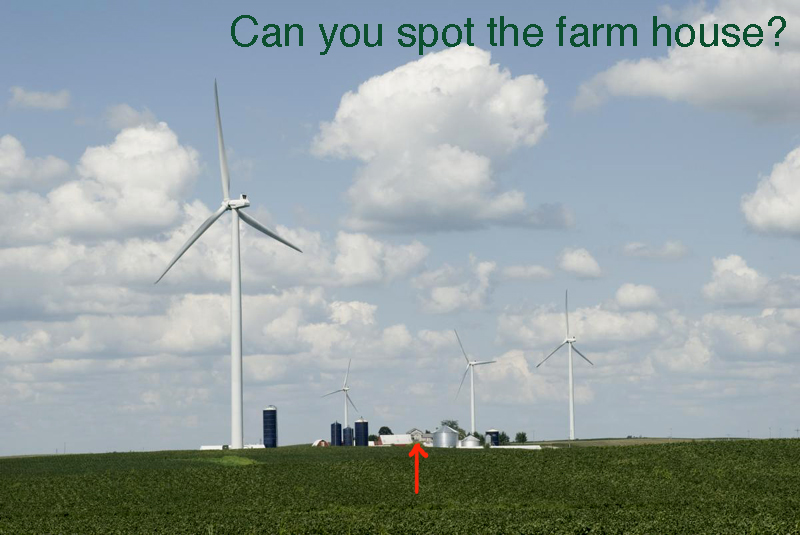
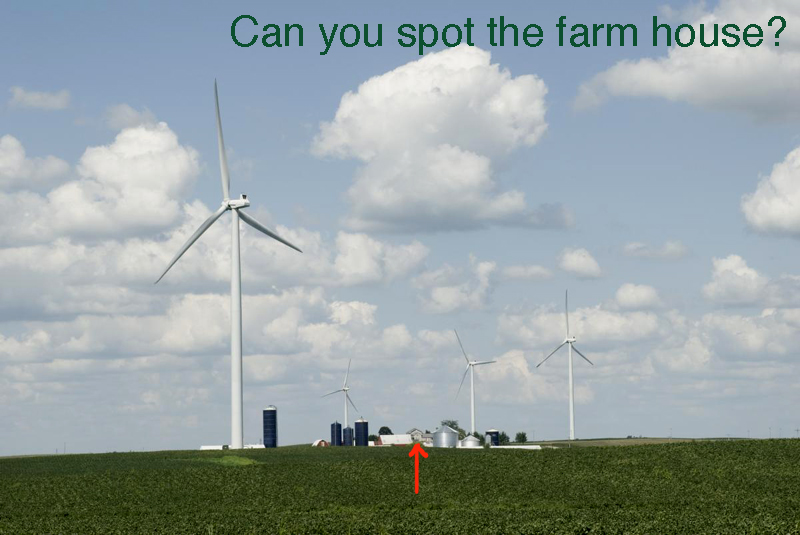
Wind turbines on a Wisconsin Farm
While I support the overall rule because it will promote the development of wind in Wisconsin, the rule fails to provide a much-needed safety net for people whose health declines because of a Wind Turbine located near their home.
-PSC Commissioner Lauren Azar
CLICK HERE TO DOWNLOAD THE FINAL WIND RULES FROM THE PUBLIC SERVICE COMMISSION
SOURCE: PSC DOCKET # 1-AC-231
From PSC commissioner Lauren Azar
To The Honorable Fred Risser The Honorable Michael Sheridan
The State Senate The State Assembly
State Capitol, Room 220 South State Capitol, Room 211 West
Madison, WI 53702 Madison, WI 53702
Re:Wind Siting Rules, Clearinghouse Rule 10-057
Dear Senate President Risser and Speaker Sheridan:
I write to explain my concurrence with the Commission’s rule on the siting of certain wind energy systems (Wind Turbines) in Wisconsin.
While I support the overall rule because it will promote the development of wind in Wisconsin, the rule fails to provide a much-needed safety net for people whose health declines because of a Wind Turbine located near their home.
The safety net I propose would be a minimal burden to wind developers while simultaneously protecting Wisconsin citizens who are sensitive to the noise emitted from Wind Turbines.
Among other things, 2009 Wisconsin Act 40 requires the Commission to develop rules that “provide reasonable protection from any health affects” associated with Wind Turbines. Wis. Stat. § 196.378(4g)(b).
There is substantial evidence that noise from Wind Turbines could negatively impact the health of a small percentage of the population.
To better ensure compliance with Act 40’s mandate, I proposed the following safety net: under limited circumstances, the owner of a Wind Turbine must purchase, at fair market value, the home of someone who can prove that a nearby Wind Turbine is directly causing a significant adverse health outcome. [1]
Unfortunately, at this time, we cannot accurately identify the precise line between safe levels of noise from Wind Turbines and those levels that will negatively affect human health.
Nor do we know why a small percentage of the population is affected more negatively by Wind Turbines than the rest of the population.
As new information becomes available, the Commission can revise this rule.
While more study is needed to better understand the full health impacts of Wind Turbines, it is important that we establish some remedy for the people who can prove that their health is being compromised by nearby Wind Turbines before the Commission has an opportunity to revise this rule.
To be clear, this safety net does not include awarding damages to the injured party; instead, it allows the injured party to move quickly from the area, thereby abating health concerns.
The safety net would be limited to landowners who provide evidence (in the form of a certification) from a licensed Wisconsin medical doctor that one or more Wind Turbines have directly caused a significant adverse health outcome on the injured party.
The only impact to the owner of the Wind Turbine(s) would be the need to resell the house.
Hence, the proposed safety net would not be an onerous requirement on the Wind Turbine owner and should not hamper wind development in Wisconsin.
The safety net could be structured as follows:
“PSC 128.XX Individual Hardships. If the owner of a nonparticipating residence experiences adverse health outcomes that are shown to be the direct result of the operation of a wind energy system, the owner of the nonparticipating residence may petition the political subdivision for mitigation of the adverse health outcomes.
The petition for mitigation shall be referred to the Commission, which may order mitigation of the adverse health outcomes.
A medical doctor licensed in the State of Wisconsin shall attest that that one or more wind turbine(s) have caused a significant adverse health outcome on the injured party before any relief may be granted under this section.
Mitigation may include requiring the owner of the wind energy system to purchase the nonparticipating residence at fair market value.
Note: The Wind Siting Council may make recommendations with respect to the form and type of information that is required to show that adverse health outcomes are the direct result of the operation of a wind energy system.
Absent a safety net provision like this, it is unclear how an injured party could obtain mitigation of adverse health outcomes from a Wind Turbine owner.
If they are unable to sell their property for fair market value, injured parties would be forced to file suit against the owner of a Wind Turbine.
This could require the injured party to incur significant legal costs that are not recoverable in a lawsuit and may dwarf the value of the home.
The State of Wisconsin should not place its citizens in this position.
In conclusion, while I concur with the rule as a package, I remain concerned that this rule fails to protect the most vulnerable of our community and, therefore, I must qualify my support of this important rule. When this rule is referred to the appropriate standing committees, please forward a copy of this letter with the rule.
Sincerely,
Lauren Azar
Commissioner
[1] The operation of this safety net proposal is not unprecedented. The Commission recently identified that the purchase of property at fair market value was a potential remedy for two landowners affected by a large wind energy development. Because the two landowners had a significant number of Wind Turbines within view from their homes, the Commission required mitigation, including the possibility that the utility purchase the properties at fair market value. The utility did not object to this potential remedy and has since purchased the properties.
SECOND FEATURE
In Wisconsin, Facts About ‘Green Job’ Creation Elusive as the Wind
SOURCE MacIver News Service | September 1, 2010
By Bill Osmulski
MacIver News Service Investigative Reporter
[Madison, Wisc...] Although they are touted and promoted by policy makers and opinion leaders across the state, accurately defining and keeping track of ‘green jobs’ has proven nearly impossible in Wisconsin.
Take, for example, ‘green jobs’ associated with the wind industry.

Wisc. Governor JimDoyle (D)
“Clean energy technology and high-end manufacturing are Wisconsin’s future,” Governor Jim Doyle said in his final State of the State address. “We have more than 300 companies and thousands of jobs in the wind industry.”
That statistic is impossible to verify.
The State of Wisconsin does not track those companies nor the jobs within the industry.
When contacted, the Office of Energy Independence (an agency created by Governor Doyle in 2007) directed MacIver News to Wisconsin Wind Works, a self-described “consortium of manufacturers representing the wind manufacturing supply chain within Wisconsin.”
The advocacy group maintains an online wind energy-related supply chain database, although a routine examination of the data proved just how unreliable the figures are.
When the online, searchable database was utilized earlier this summer, it listed 340 companies in Wisconsin connected to the wind industry, a fact which, without additional investigation would appear to be in line with the Governor’s statement.
However, further examination showed many of those companies were not currently serving the wind industry and were only listed because they someday could serve the wind industry.
For example, the database listed 38 manufacturers, but only 24 of them have anything to actually do with the wind energy sector presently.
Of those 24 Wisconsin manufacturers, only eight were categorized as primary suppliers.
Another four companies were listed as both primary and secondary suppliers. A MacIver News Service reporter contacted all eight primary suppliers and the four companies listed as primary/secondary suppliers in our initial query and what we found further eroded the credibility of Governor Doyle’s claims.
When contacted, the companies listed as both primary and secondary suppliers all described themselves merely as secondary suppliers. That means they produce products that are not exclusive to the wind energy.
For example, Bushman Equipment manufactures lifts that move heavy pieces of equipment, which, among many other uses, can be used to handle wind turbines.
Wisconsin Wind Works’ database is not only generous with the number of companies within their supply chain it associates as being primary suppliers, there are issues with the actual job numbers listed for each company as well.
Many of the figures are either inflated, the jobs are not located in Wisconsin, or they cannot be tied to wind energy.
For example, Rexnord Industries was one of the eight Wisconsin manufacturers listed in our query as directly serving the wind energy industry. The database shows the company has 6,000 employees.
Yet a Rexnord official told the MacIver News Service that the company only has 1,500 employees in Wisconsin, and only five of those have jobs which are directly tied to the wind industry.
Wisconsin Wind Works’ database says Orchid International has 600 employees, but a company spokesperson told MacIver it only has 150.
Amsoil Inc. in Superior has 236 employees listed in the Wisconsin Wind Works database, but a company representative told the MacIver News Service that only 6 of them work on wind energy-related products.
In all, at the time of our search, the database claimed 7,632 jobs among the eight manufacturers that were current primary suppliers to the wind industry. Yet, the MacIver News Service was only able to identify 31 jobs at those companies which were specifically tied to wind energy related products.
Manufacturers told MacIver News that other employees might work on wind-related products occasionally, but it does not represent the bulk of their workload.
Another 1,077 workers are listed among the secondary suppliers and we did not investigate that claim.
VAL-FAB, one of the companies listed as both a primary and secondary supplier, explained to MacIver News that it initially had high hopes for the wind energy industry that never materialized. The company specializes in fabrication for the energy sector.
William Capelle, Director of Business Development at VAL-FAB, said “At first we thought we might be able to manufacture the actual towers, but it turns out 90 percent of those are imported from Spain.”
Since the MacIver News Service first examined the Wisconsin Wind Works database, the number of companies listed has increased to 360.
A reporter attempted to contact the organization for comment about the veracity of their data, but Wisconsin wind Works, which solicits members by selling itself as the
“preferred partner of wind energy professionals,” did not respond.
They are, however, holding a Wind Energy Symposium in Milwaukee on October 13th.
Meanwhile the Office of Energy Independence continues to pursue the Doyle Administration’s green energy policies.
As Doyle said during his final State of the State address, “anyone who says there aren’t jobs in the clean energy economy had better open their eyes.”
There is no doubt that some jobs in the wind industry exist in Wisconsin. The accurate number of these ‘green jobs’ is proving to be, at best, elusive
Representatives of Doyle’s office did not respond to repeated request for comments regarding the information contained within this article.
THIRD FEATURE
What to expect when you're expecting wind turbines close to 500 feet tall:
Photos from the Town of Glenmore in Brown County Wisconsin
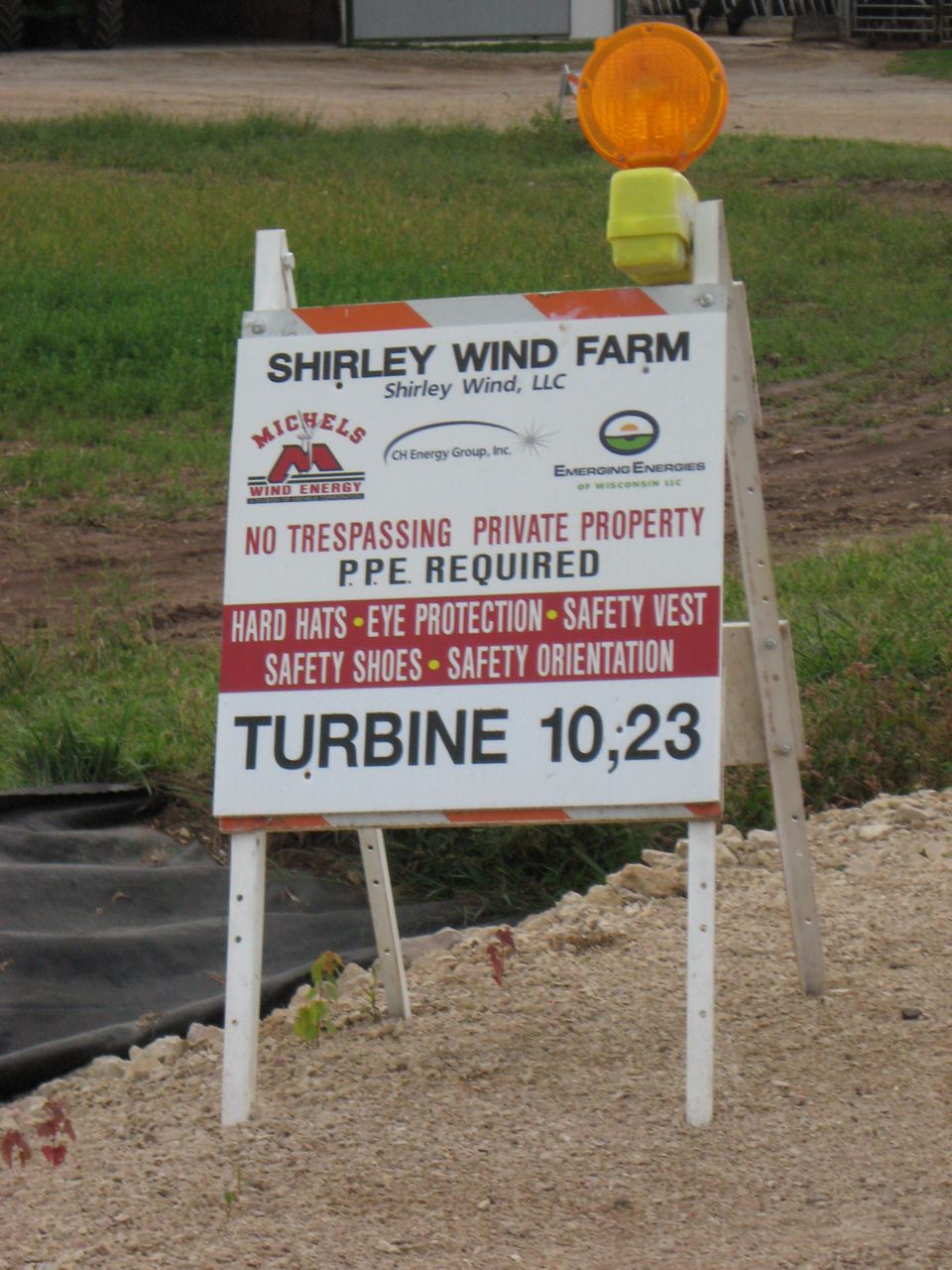

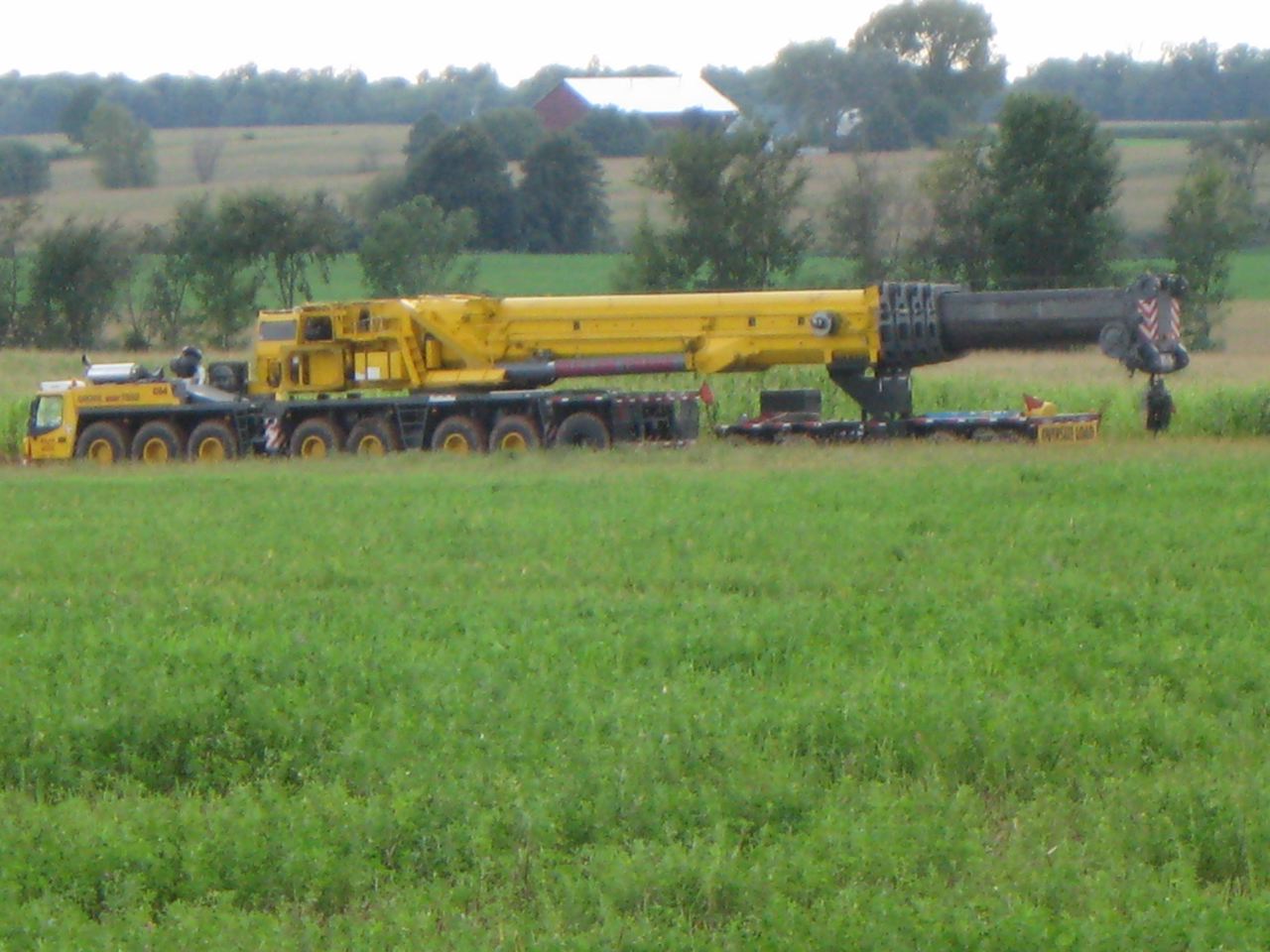

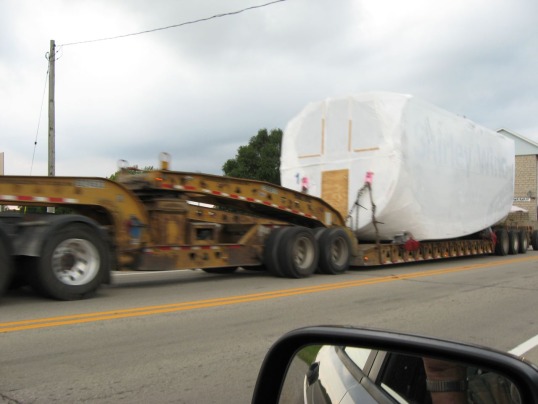




Construction underway on Brown Co. wind farm
8 turbines in Town of Glenmore
TOWN OF GLENMORE - Construction is underway on Brown County's first industrial wind farm. Eight wind turbines are being built in the Town of Glenmore in southern Brown County.
The developer, Wisconsin-based CH Shirley Wind, LLC, says construction is to be completed by the end of the year. The 8 wind turbines are expected to generate enough power to supply approximately 8,000 homes per year.
The wind turbines will stand 492 feet tall.
"We are hoping to generate power by the end of September on at least one turbine. Hopefully all 8 by the end of October," said John Roberts, the construction manager for the project.
The turbines will also provide some extra income for the four families hosting them on their properties.
"They're not just doing it for the money. They like the idea of being green and using their farm for something like this," said Roberts.
Though, like most wind developments, a number of neighbors aren't too happy with the project.
"The projects right now, with the setback rules we have, are just too close for people to live in that proximity to an electrical generator of that size," said Jamie Fletcher, who lives in the Town of Glenmore.
Fletcher has been working to stop all large-scale wind development in southern Brown County. She believes wind turbines cause health problems, mainly from all the noise they make.
"Insomnia, shadow flickers, causing everything from nauseasness to epileptic seizures and I don't want to put my family through that or my animals," said Fletcher.
However, a state committee that studied the issue recently found no health effects from the turbines. Those working on the project in Glenmore also say the turbines being built there have new technology that make them less noisy.
"They're a little bit higher and they turn a little bit slower and because they turn slower, there is actually less noise," said Roberts.
The Shirley Wind project is not part of a highly publicized proposal to build 100 wind turbines in several Brown County communities. That proposal, known as the Ledge Wind Energy Project, has not been voted on yet by the state Public Service Commission. It is being developed by a Chicago-based company called Invenergy.
Opponents, like Jamie Fletcher, say the 8 turbine project in Glenmore will be an example of why other projects should be stopped.
"Whatever happens out here, I pray it's a wake-up call for the rest of the state," she said.
Both sides will continue to debate whether wind development is what is best for Wisconsin.
THIRD FEATURE: A LETTER FROM MAINE:
Note: Like Wisconsin, Maine also passed law that streamlines wind siting for developers by removing local control and relaxing restrictions. Here is what Maine residents are saying two years later:
Though I’d suspected the news would eventually arrive, I still wasn’t ready when I got it.
Word came recently that a wind speed test tower, the harbinger of a future wind turbine development, would soon be erected just north of my property in Lexington Township.
Two more associated towers are to be located in Concord, the next township to the east.
My town is now among the unfortunate that have been infected with the virus of wind-energy sprawl. Industry activity, lately, has been substantial in our area and our town lies within the new expedited permitting zone. It was bound to happen.
I’ve been working to stop wind-sprawl on Maine’s rural landscape for almost a year.
However, until now, I’ve not known the full complement of the frustration, indignation and betrayal felt by so many Mainers seeing their lives turned upside down by the reckless and uncaring intrusion of this industry on their homes and property — all with the complicity of our state government.
I have worked beside many of these people for months, but only now do I fully understand their perspective.
My wife and I believed we’d spend the rest of our days in Lexington, living simply, and feeling fortunate to be surrounded by Maine’s unique beauty and the increasingly rare silence of a rural land.
The governor and Legislature, however, sealed our fate in 2008 when they gifted the wind industry with easy permitting terms for a scheme that is unlikely to produce benefits greater than what will be stolen from present and future generations.
Under the new laws, property owners have been left with little power to protect themselves. I will, nevertheless, continue to fight this industry’s assault on rural Maine, perhaps, with a keener awareness of what we stand to lose.
Alan Michka
Lexington
7/26/10 TRIPLE FEATURE: From open arms to balled up fists: Wisconsin resident comments on living in a wind project under construction AND Why he left the family farm: Wisconsin resident lays out his first-hand experience with wind development. The majority of the Wind Siting Council looks the other way
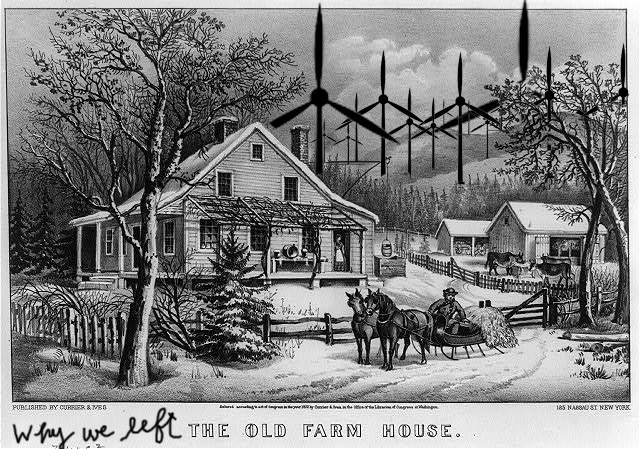
PUBLIC COMMENT TO PUBLIC SERVICE COMMISSION FROM RESIDENT OF PSC APPROVED GLACIER HILLS PROJECT CURRENTLY UNDER CONSTRUCTION:
To the landowners in the Ledge Wind Project:
If you believe wind turbines are a good fit for a farm operation, a free source of clean energy, and a benefit to your community, I invite you to come to the Glacier Hills Project and witness the total devastation occuring during construction.
Seeing firsthand what is happening here would turn any responsible landowner's stomach.
Heavy rains have created erosion that will take years to repair.
The number of huge construction equipment and trucks burning fuel is staggering.
Good productive farmland is being ripped apart, and will never be the same.
The level of disgust is even affecting the most loyal supporters of this project.
Hatred of this project is growing worse as each day passes, and we will be forced to live with this for the rest of our lives, all because a few irresponsible landowners, myself included, were taken in by wind developers lies.
All this for chump change.
I affirm that these comments are true and correct to the best of my knowledge and belief.
Gary Steinich
Cambria, WI
SECOND FEATURE
TESTIMONY
Comments submitted by Wisconsin resident, Joe Yunk, to the Public Service Commission of Wisconsin, July 2010
My name is Joe Yunk; I currently reside at the address of N2630 Townhall Rd in Kewaunee County.
My prior address was North 7905 County Trunk P, Algoma, Wisconsin which was in the Wisconsin Public Service (WPS) wind farm by Rio Creek, Wisconsin. I moved from the Algoma address to my current address on or about October 2009 to get away from the effects of the WPS wind farm.
I have been following the current proposed Element Power LLC (EEP) wind farm development that I now find myself living in.
I want you to know what I went through while living in the WPS wind farm. I am hopeful that this information will help you make the right decisions with regard to any PSCW approvals for any other wind farms in Wisconsin.
I would hate to see other peoples’ lives to be as negatively affected as mine has been as a result of living in a wind farm. There is no doubt in my mind that I will relive the awful experience once again if the EEP wind farm for Kewaunee County is approved.
In 1998 the WPS wind farm construction began about 300 yards from my home. I had built this home in 1980 on 6.5 acres of land which was our home farm that I lived on all my life. I was born on November 28, 1954. I had two turbines within one-half mile, one of those turbines was about 1,300 ft from my house and 600 ft from my property line.
In the summer of 2000, the turbines of the WPS wind farm began operation. Inasmuch as I had lived on this farm all my life, I knew the neighbors well, and it wasn’t long after the turbines began operating our lives began to change.
In conversations with my neighbors, I learned, they too were experiencing constant disturbing noise, shadow flicker and just the constant presence of the turbines. By presence I felt uneasy and irritated by the size and closeness of these 220 ft. turbines.
All the people living in this wind farm were guinea pigs/lab rats, no one knew what we were in for. It was in the fall of 2000 when neighbors and families began to divide over the effects of the wind farm. And that continued throughout the time I lived there.
When the turbines began to operate, a hotline was established directly to WPS to report any problems.
I had beef cattle for about two years prior to the turbines operating and never lost any animals. However, shortly after the turbines began to operate, I had beef cattle become ill and die. I reported this on the WPS hotline and nothing was done. I lost ten animals valued at $5,000 [each] over a two year period and couldn’t afford to continue.
Because of noise complaints to WPS, within a year, two families’ homes were purchased by WPS and demolished.
Additionally, at the same time WPS was settling nuisance suits with other neighbors. They were offering to buy out my neighbors but offered prices way below market value to stop the complaints.
However, they never offered me any buyout opportunity and I wanted out! It was hard for me to leave my home place of 54 years. Over time, however, living with the constant sleep deprivation and irritation of the noise and flickering I decided to sue WPS to have them pay me fair market value for my home so I could afford to move.
I knew that I might be risking everything I had worked for all my life, but I didn’t care at this point. I didn’t even try to sell my place outright because I didn’t want anyone else to have to live as I did in this wind farm. I really wanted WPS to buy me out and to demolish the home.
I retained an attorney and filed suit with WPS. Shortly after, WPS offered me $110,000 on my property that appraised for $168,000. I decided not to take their offer, but proceed with the suit.
I gave deposition in the summer of 2008, we were scheduled to go trail in September 2009 and WPS offered me a settlement in August of 2009 for $163,000. With this settlement I was responsible for my attorney fees. My attorney advised me to accept this offer. After paying my attorney fees, I ended up with $158,000.
Later, my home and property were listed with a real estate agency for sale by WPS for 30% below the appraised value.
From my experience in living in this wind farm, it is apparent that setback away from property lines is absolutely necessary. I could hear the turbines a mile away from my house. The PSCW’s standard setback from a property line should be 1.5 miles.
Now, my new home and property on Townhall road is within the confines of the EPP proposed wind farm. I`d like to know what you recommend I do now?
WIND TURBINES IN THE NEWS:
Annie Hart Cool of Falmouth said a turbine was erected within 1,500-feet of her home and has disrupted her husband’s sleep so severely he’d forced to sleep in the basement. He is an air-traffic controller, she added, and can’t afford to lose sleep. And the turbine is absolutely adversely impacting property values, she said.
“Wind turbines are like living next to a train or a dump,” Cool said. “These are realities, I’m a real person and this is really happening to me.”
SOURCE: State House News Service, www.wickedlocal.com
7/24/10 Double Feature: WRITING THE WIND RULES: The World Health Organization says one thing, McFadden says another: Which recommendation carries more weight? AND Is something is rotten in Denmark?
In this short clip, Dr. Jevon McFadden pushes for a noise level that may be more beneficial to wind developers than residents of rural Wisconsin.
If the World Health Organization says nighttime noise levels should be 40 decibels or less why is he recommending a louder noise limit?
Does he know something they don't?
Unfortunately for residents of rural Wisconsin, no one is asking the question.
NOTE: TO VIEW HIGH QUALITY VIDEO OF THE COMPLETE WISCONSIN WIND SITING COUNCIL MEETINGS, VISIT THE GREAT WISCONSIN EYE WEBSITE BY CLICKING HERE
SECOND FEATURENEIGHBORS ON THE BARRICADES AGAINST
WIND TURBINES IN DENMARK
SOURCE: Jyllandsposten: http://jp.dk/indland/article2131636.ece
July 24, 2010
By Peter Skeel Hjorth
The postcard image of Denmark in harmony with wind turbines has shattered.
Protests from more and more Danish neighbours of wind turbines on land have stopped wind power projects and made local politicians reluctant to approve licences. This is evident from a front page article in yesterday’s edition of Jyllandsposten which is one of the country’s biggest national newspapers.
Denmark has up till now systematically been highlighted as the good example where the population live in harmony with more than 5000 wind turbines that produce 20 per cent of the country’s electricity. The postcard image of Denmark with Vestas and Siemens as the main producers of wind turbines has shattered.
Several places around the country see acrimonious conflicts between the authorities and neighbours of wind turbines, writes Jyllandsposten.
The case about a national test centre is not the only example of growing resistance. With a broad majority behind it in the Danish parliament the government will build a test centre for seven 250 meter high sea wind turbines in Northern Jutland and clear 5 square kilometres of forest area to create the right wind conditions. For more information click here www.nationalttestcenter.dk.
One of the strongest critics of Danish wind power, the well-known journalist and columnist Claes Kastholm Hansen, calls it a democratic scandal.
“People are thoroughly fed up having their property devalued and their sleep disturbed by big wind turbines 130 and up to 200 meters high” , says the chairperson of a new Danish national association to Jyllandsposten.
The association was started about a year ago. 40 Danish protest groups have already joined, and more are on their way. Several places protests have put a stop to the erection of wind turbines or made the council exercise restraint, writes the newspaper. On Sealand the Swedish energy giant Vattenfal has been forced to abandon the erection of three huge wind turbines. A narrow majority in the local council voted no to two of them after severe pressure from protesting neighbours.
7/8/10 Meet Me at Van Ables: Brown County is Getting the Word Out: The trouble with siting industrial scale wind turbines 1000 feet from homes
 Wind Farm Meeting Tonight in Holland
Wind Farm Meeting Tonight in Holland
SOURCE: Greenbay Press Gazette
July 8, 2010
By Jon Styf
A group that has opposed a proposal to build a 100-turbine wind farm in southern Brown County will host what it calls an informational meeting tonight in Holland.
Chicago-based Invenergy LLC has proposed the wind farm in Morrison, Glenmore and Wrightstown. It is waiting to resubmit its application until the guidelines are approved by the PSC.
The Brown County Citizens for Responsible Wind Energy has organized tonight's meeting scheduled for 6:30 at Van Abel's of Hollandtown, 8108 Brown County D in the town of Holland.
